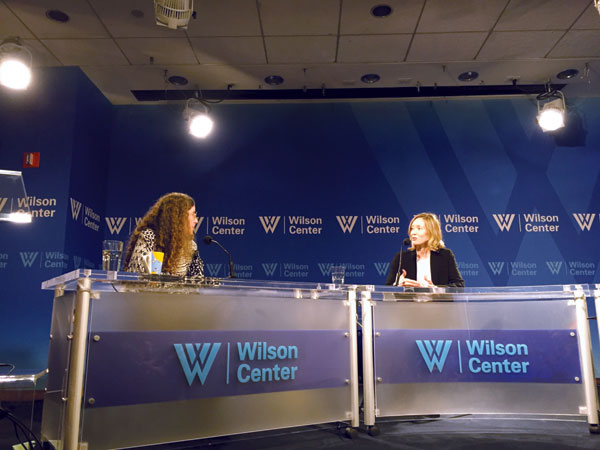Cotton's pained Odyssey explored
By LIU CHANG in Washington (China Daily USA) Updated: 2015-03-20 10:51
 |
|
Jennifer Turner (left), director of the China Environment Forum of the Wilson Center, and Laura Kissel (right), director of the documentary The Cotton Road, talk about the film after its screening at the Wilson Center in Washington on Wednesday. Liu Chang / China Daily. |
Based on universal density standards, a 55-by-28-by-21-inch bale of cotton weighs about 500 pounds and can be turned into 325 pairs of blue jeans.
Statistics show that in the US,each person consumes about 68 pounds of textile a year and overall Americans buy 20 billion new items of clothing.
Rarely do they think about the supply chain journey clothes go through - how they're made, who produces them and what those people go through.
A documentary film, The Cotton Road, directed by Laura Kissel, takes viewers on a journey with cotton from South Carolina to China that tries to stitch together some answers.
It was shown on Wednesday at the Woodrow Wilson Center as part of the 23rd Environmental Film Festival in Washington, which runs from March 17 through 29. More than 160 films from 31 countries are screened to promote dialogue and build understanding of environmental challenges and opportunities.
The Cotton Road tracks pure cotton from where it is planted on a large farm in South Carolina in 2008. In autumn, the cotton gin separates cotton fiber from the seed. The lint makes its way through a series of pipes and is then compressed into bales, wrapped and loaded for shipment to China.
Scenes in the Chinese factoriesexplore several issues, fromthe plight of migrant workers and young workers missing out on education topoor salariesand benefits and unfair working conditions.
The film, which took six years to make, tells stories about "ordinary people",Kissel said.
"I hope the film can help people reflect a little more on their choices," she said, "think a little bit differently about commodities and the supply chain, and, of course, the human beings who are in the supply chain."
"It's a global machine we built," said Jennifer Turner, director of the China Environment Forum of the Wilson Center. "It's both beautiful and ugly."
Who is the antagonist in the film? Kissel wants people to answer that question for themselves.
Matt McFall, program officer of the World Wildlife Fund, said the people highlighted in the documentary are the epitome of the global supply chain, who live the details of the industrial processes.
McFall said corporations should realize that to improve social and labor issues is to increase profitability in the long run.
Kisselsaid Chinese people were very welcoming when she went there to make the film. She was impressed by people's generosity in sharing their lives, and a "partnership" bond formed between the filmmaker and people.
Shooting in the factories did not always go smoothly because of how busy everyone was. "They have to work so fast in a very short amount of time. So any sort of distraction was not what the manager was looking for," she said.
A Chinese migrant worker in a Shanghai fashion factory told of the pain she endured when her tearful father apologized saying that the family had to ask her to quit her schooling because they lacked money. All she hoped for was to work well and earn enough money for her family's shattered house to be repaired.
changliu@chinadailyusa.com






